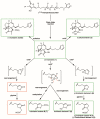Discovery of Ircinianin Lactones B and C-Two New Cyclic Sesterterpenes from the Marine Sponge Ircinia wistarii
- PMID: 36005535
- PMCID: PMC9410537
- DOI: 10.3390/md20080532
Discovery of Ircinianin Lactones B and C-Two New Cyclic Sesterterpenes from the Marine Sponge Ircinia wistarii
Abstract
Two new ircinianin-type sesterterpenoids, ircinianin lactone B and ircinianin lactone C (7 and 8), together with five known entities from the ircinianin compound family (1, 3-6) were isolated from the marine sponge Ircinia wistarii. Ircinianin lactones B and C (7 and 8) represent new ircinianin terpenoids with a modified oxidation pattern. Despite their labile nature, the structures could be established using a combination of spectroscopic data, including HRESIMS and 1D/2D NMR techniques, as well as computational chemistry and quantum-mechanical calculations. In a broad screening approach for biological activity, the class-defining compound ircinianin (1) showed moderate antiprotozoal activity against Plasmodium falciparum (IC50 25.4 μM) and Leishmania donovani (IC50 16.6 μM).
Keywords: Ircinia wistarii; Leishmania donovani; NCI-60; Plasmodium falciparum; antiprotozoal activity; bioactivity screening; ircinianin-derivates; sesterterpene; sponge.
Conflict of interest statement
The authors declare no conflict of interest.
Figures






Similar articles
-
New Metabolites from the South China Sea Sponge Diacarnus megaspinorhabdosa.Chem Pharm Bull (Tokyo). 2015;63(6):438-42. doi: 10.1248/cpb.c15-00022. Chem Pharm Bull (Tokyo). 2015. PMID: 26027468
-
New Cytotoxic 24-Homoscalarane Sesterterpenoids from the Sponge Ircinia felix.Int J Mol Sci. 2015 Sep 11;16(9):21950-8. doi: 10.3390/ijms160921950. Int J Mol Sci. 2015. PMID: 26378524 Free PMC article.
-
Sesterterpene glycinyl-lactams: a new class of glycine receptor modulator from Australian marine sponges of the genus Psammocinia.Org Biomol Chem. 2013 Jul 28;11(28):4695-701. doi: 10.1039/c3ob40861b. Epub 2013 Jun 11. Org Biomol Chem. 2013. PMID: 23760172
-
Bioactive sesterterpenes and triterpenes from marine sponges: occurrence and pharmacological significance.Mar Drugs. 2010 Feb 23;8(2):313-46. doi: 10.3390/md8020313. Mar Drugs. 2010. PMID: 20390108 Free PMC article. Review.
-
Identification of Anthelmintic Bishomoscalarane Sesterterpenes from the Australian Marine Sponge Phyllospongia bergquistae and Structure Revision of Phyllolactones A-D.J Nat Prod. 2022 Jul 22;85(7):1723-1729. doi: 10.1021/acs.jnatprod.2c00229. Epub 2022 Jun 21. J Nat Prod. 2022. PMID: 35727327 Review.
Cited by
-
Marine-Derived Diterpenes from 2019 to 2024: Structures, Biological Activities, Synthesis and Potential Applications.Mar Drugs. 2025 Feb 7;23(2):72. doi: 10.3390/md23020072. Mar Drugs. 2025. PMID: 39997196 Free PMC article. Review.
-
Promising Antiparasitic Natural and Synthetic Products from Marine Invertebrates and Microorganisms.Mar Drugs. 2023 Jan 25;21(2):84. doi: 10.3390/md21020084. Mar Drugs. 2023. PMID: 36827125 Free PMC article. Review.
-
A Novel Sesterterpenoid, Petrosaspongin and γ-Lactone Sesterterpenoids with Leishmanicidal Activity from Okinawan Marine Invertebrates.Mar Drugs. 2024 Dec 30;23(1):16. doi: 10.3390/md23010016. Mar Drugs. 2024. PMID: 39852518 Free PMC article.
-
Bioactive Terpenes from Marine Sponges and Their Associated Organisms.Mar Drugs. 2025 Feb 21;23(3):96. doi: 10.3390/md23030096. Mar Drugs. 2025. PMID: 40137282 Free PMC article. Review.
References
-
- Manes L.V., Naylor S., Crews P., Bakus G.J. Suvanine, a novel sesterterpene from an Ircinia marine sponge. J. Org. Chem. 1985;50:284–286. doi: 10.1021/jo00202a030. - DOI
-
- Höller U., König G.M., Wright A.D. Two New Sesterterpene Tetronic Acids from the Marine Sponge Ircinia oros. J. Nat. Prod. 1997;60:832–835. doi: 10.1021/np970170y. - DOI
-
- Wright A.E., McCarthy P.J., Schulte G.K. Sulfircin: A new sesterterpene sulfate from a deep-water sponge of the genus Ircinia. J. Org. Chem. 1989;54:3472–3474. doi: 10.1021/jo00275a037. - DOI
-
- Barrow C.J., Blunt J.W., Munro M.H.G., Perry N.B. Oxygenated Furanosesterterpene Tetronic Acids from a Sponge of the Genus Ircinia. J. Nat. Prod. 1988;51:1294–1298. doi: 10.1021/np50060a047. - DOI
MeSH terms
Substances
Grants and funding
LinkOut - more resources
Full Text Sources
Molecular Biology Databases

